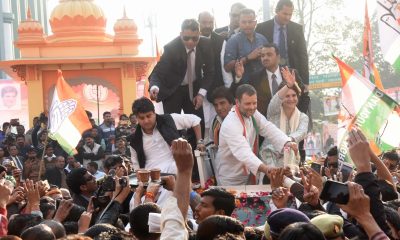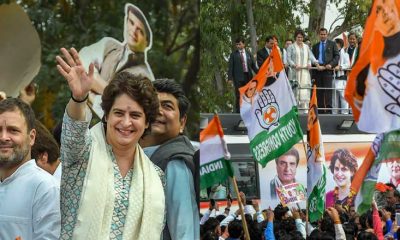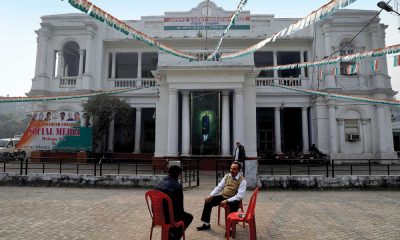Top News
2,234 get HIV via blood transfusion; government claims ignorance
 As many as 2,234 people contracted the human immunodeficiency virus (HIV) after receiving blood transfusions in hospitals between October 2014 and March 2016, according to data released by the National AIDS Control Organisation (NACO), but the government told Parliament it did not know of these infections.
As many as 2,234 people contracted the human immunodeficiency virus (HIV) after receiving blood transfusions in hospitals between October 2014 and March 2016, according to data released by the National AIDS Control Organisation (NACO), but the government told Parliament it did not know of these infections.
The information was made available by NACO when it replied to a right-to-information (RTI) request filed by activist Chetan Kothari earlier this year.
“No,” was the reply the Ministry of Health — NACO’s parent organisation — gave on August 16, 2016, to a question from Congress member of Parliament and former minister Jyotiraditya Scindia asking if the government was aware that “a large number” of people nationwide had been infected with HIV while getting blood transfusion.
“The limitations of available testing methods while screening blood units for HIV in blood banks as a result of which possibility of HIV transmission during blood transfusion cannot be completely ruled out,” the ministry said in its reply.
India fell 9 per cent short of its blood requirement in 2015-16, IndiaSpend reported September 3, with prosperity dictating availability; Bihar, for instance, was 84 per cent short of its blood requirements and Chhattisgarh 66 per cent short, while Chandigarh was over-supplied nine times and Delhi three times.
NACO disputes the reliability of the data it released, claiming that it “refers to information on self-reported transmission of HIV”, and is “not corroborated by any scientific means to confirm that transmission is indeed due to blood transfusion”.
Blood transfusion is deemed “as an acceptable way of getting infected, rather than others showing bad lifestyles”, said Zarin Bharucha, pathologist and chairperson of Federation of Bombay Blood Banks.
Only South Africa and Nigeria have more HIV patients than India, where more than two million people are infected, according to a 2015 NACO report.
Despite a 5 per cent decline in the number of patients testing positive for HIV since 2007, 86,000 new infections and 68,000 AIDS-related deaths are reported every year.
Up to 95 per cent of India’s HIV transmissions are caused by unprotected sex, according to a December 2015 answer to the Lok Sabha.
Blood transfusions account for 0.1 per cent of HIV infections, according to data released in the Lok Sabha reply, but based on NACO figures, it would account for 1.7 per cent.
Either way, the number of HIV infections through blood transfusions should be zero: the US reported its last such case in 2008, the UK 2005 and Canada 1985.
It is mandatory for hospitals to screen donors and donated blood for what are called transfusion-transmitted infections, such as HIV, hepatitis B and C, and malaria. That isn’t always done, and when it is, the chances of ruling out HIV-positive blood are not 100 per cent.
There is a window between the contraction of the virus and the production of anti-HIV antibodies in the blood that leads to the virus being undetected by tests. This period varies depending on the sensitivity and specificity of the test.
“The blood transmission mainly occurs in this period,” said Bharucha. “Most of the (blood) banks use recent testing to shorten the window period, but these tests are expensive, so they are not used in many government-run hospitals.”
Introduced in 2001, the nuclear acid amplification test has reduced the length of time HIV might be undetected to between seven and nine days, from two weeks and some months previously.
Some states lack adequate HIV-testing facilities. In Jharkhand, 17 of the 24 districts did not have test facilities, according to a 2015 India Today report.
There are an estimated 19,800 integrated counselling and testing centres (ICTCs) nationwide, an increase of 4,194 over the last three years. There should be at least one ICTC in every district, according to National AIDS Control Programme (NACP) rules.
The inconsistency in government funding for the NACP has not helped: The government slashed funding in 2014-2015 by 26 per cent compared to the previous two years, then increased it over the last two years by 31 per cent. The NACP budget for 2016-17 is still 3 per cent less than it was in 2012-2013.
The lack of testing facilities leads hospital staff to rely on what is called “pre-donation history”, an account of donations made by a donor.
“Relying on pre-donation history means if donors do not give personal history correctly, their blood is at risk,” said Bharucha.
In a country where being HIV positive is still considered a social stigma — infected people tend to hide the fact — not testing blood and donors is a gamble, as is the practice of using what are called “replacement donors”.
Hospitals short of blood often ask a patient’s family to find a donor. “Not everyone has a donor available, so they might land up getting a paid donor,” said Bharucha. Even if paid blood donations are forbidden (the Supreme Court banned them in 1996), they still take place, increasing the chances of patients getting blood that is HIV positive.
“Awareness is the key to tackle this issue,” says Bharucha. “Communities should be aware of the danger of this practice.”
(06.09.2016 – In arrangement with IndiaSpend.org, a data-driven, non-profit, public interest journalism platform. Silvio Grocchetti is a multimedia journalist and has a BA degree from Napier University, Edinburgh. The views expressed are those of IndiaSpend. Feedback at respond@indiaspend.org)
Entertainment
Casino Days Reveal Internal Data on Most Popular Smartphones

International online casino Casino Days has published a report sharing their internal data on what types and brands of devices are used to play on the platform by users from the South Asian region.
Such aggregate data analyses allow the operator to optimise their website for the brands and models of devices people are actually using.
The insights gained through the research also help Casino Days tailor their services based on the better understanding of their clients and their needs.
Desktops and Tablets Lose the Battle vs Mobile
The primary data samples analysed by Casino Days reveal that mobile connections dominate the market in South Asia and are responsible for a whopping 96.6% of gaming sessions, while computers and tablets have negligible shares of 2.9% and 0.5% respectively.
The authors of the study point out that historically, playing online casino was exclusively done on computers, and attribute thе major shift to mobile that has unfolded over time to the wide spread of cheaper smartphones and mobile data plans in South Asia.
“Some of the reasons behind this massive difference in device type are affordability, technical advantages, as well as cheaper and more obtainable internet plans for mobiles than those for computers,” the researchers comment.
Xiaomi and Vivo Outperform Samsung, Apple Way Down in Rankings
Chinese brands Xiaomi and Vivo were used by 21.9% and 20.79% of Casino Days players from South Asia respectively, and together with the positioned in third place with a 18.1% share South Korean brand Samsung dominate the market among real money gamers in the region.
Cupertino, California-based Apple is way down in seventh with a user share of just 2.29%, overshadowed by Chinese brands Realme (11.43%), OPPO (11.23%), and OnePlus (4.07%).
Huawei is at the very bottom of the chart with a tiny share just below the single percent mark, trailing behind mobile devices by Motorola, Google, and Infinix.
The data on actual phone usage provided by Casino Days, even though limited to the gaming parts of the population of South Asia, paints a different picture from global statistics on smartphone shipments by vendors.
Apple and Samsung have been sharing the worldwide lead for over a decade, while current regional leader Xiaomi secured their third position globally just a couple of years ago.
Striking Android Dominance among South Asian Real Money Gaming Communities
The shifted market share patterns of the world’s top smartphone brands in South Asia observed by the Casino Days research paper reveal a striking dominance of Android devices at the expense of iOS-powered phones.
On the global level, Android enjoys a comfortable lead with a sizable 68.79% share which grows to nearly 79% when we look at the whole continent of Asia. The data on South Asian real money gaming communities suggests that Android’s dominance grows even higher and is north of the 90% mark.
Among the major factors behind these figures, the authors of the study point to the relative affordability of and greater availability of Android devices in the region, especially when manufactured locally in countries like India and Vietnam.
“And, with influencers and tech reviews putting emphasis on Android devices, the choice of mobile phone brand and OS becomes easy; Android has a much wider range of products and caters to the Asian online casino market in ways that Apple can’t due to technical limitations,” the researchers add.
The far better integration achieved by Google Pay compared to its counterpart Apple Pay has also played a crucial role in shaping the existing smartphone market trends.
Content provided by Adverloom























